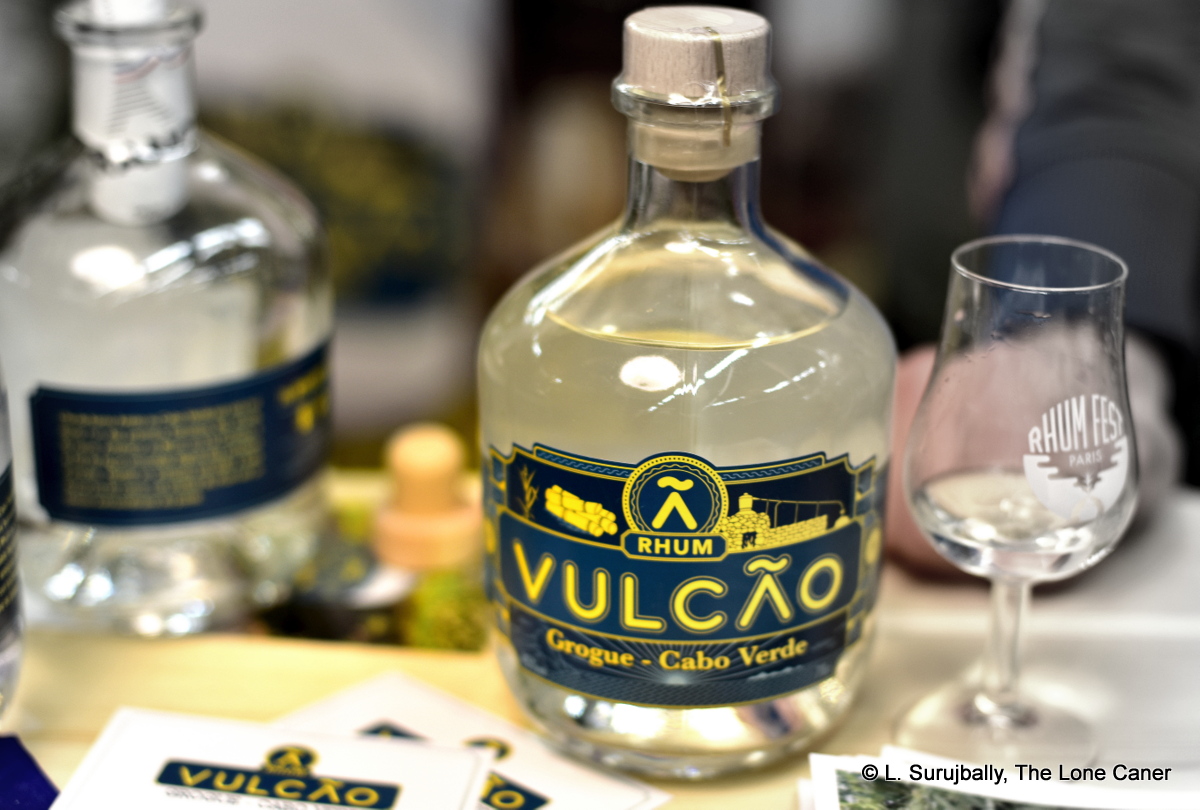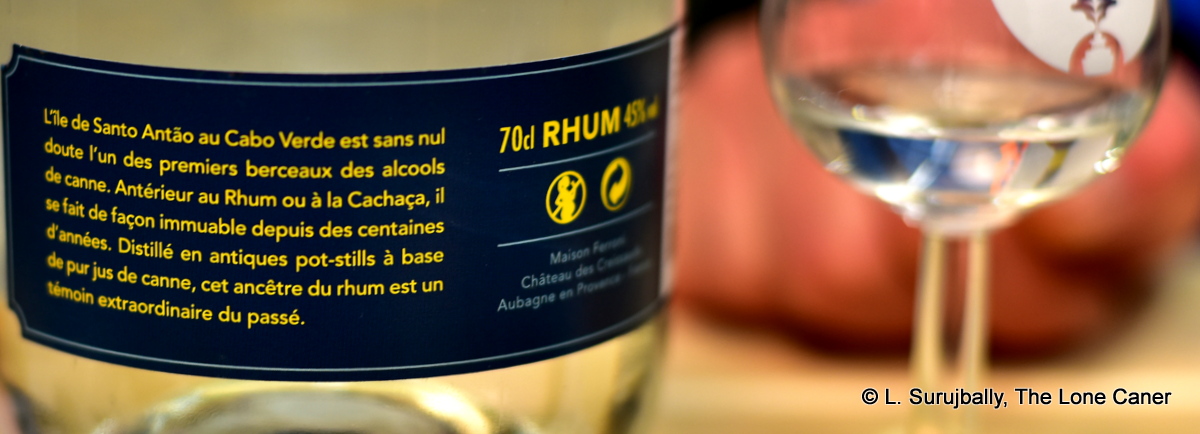
“Could grogue be the next clairin?” asked Dwayne Stewart in a facebook post the other day, when he and Richard Blesgraaf were discussing the Vulcão, and his respondent (you could almost see him smile) replied with a sort of yoda-like zen calm, “Clairin is clairin.” Which is true. Because beyond the superficial similarities of the two island nations – the relative isolation of the islands, the artisanal nature of their juice, the mom-and-pop rural distillation of the spirit far away from modern developments or technological interference – the truth is that you could not mistake one for the other. At least, not those that I’ve tried.
Take, for example, the subject of today’s review, the Vulcão grogue, which is nowhere near as ominous as its name suggests. If you have previously tried one of the four main Velier-distributed Haitian clarins (the Sajous, Vaval, Casimir and Le Rocher), marvelled at their in-your-snoot, take-no-prisoners ferocity and taste, and took Dwayne’s question to heart, you might be expecting some kind of long-gestated uber-strong clear xenomorph hammered out of Vulcan’s forge, that threatened to melt your tonsils. But it’s not. In fact, it’s closer to an off-beat agricole than anything else, and a particularly good one at that.
Even at 45% – which is practically tame for a clear rhum these days — the Vulcão smelled lovely, and started off with brine, thyme-infused water and lemon sherbet poured over a meringue cake. After five minutes or so, it also gave off scents that were creamy, salty, olive-y, with a dusting of white chocolate and vanilla, and as if impatient to continue, belched out some additional fruity whiffs — watermelon, pears, white guavas and bananas. There were also some odd minerals and ashes and iodine (not quite medicinal, but close), with overtones of sugar-water.
Short version – a yummy nose, and fortunately, it didn’t falter on the palate either. It was strong, and quite dry, unusual for a cane-juice based rhum (last time I had something so sere was years ago, with the Flor de Cana Extra Dry white). The brine and olives really came out and made an initial statement here, and combined with the sweeter elements with impressive control and in well-nigh perfect balance, making for a worthy sipping rum by anyone’s standards. With a drop or two of water came white fruits, flowers and sugar water, all of which were the slightest bit tart. And as if all that wasn’t enough, there was a light creaminess of butter pastry, Danish cookies and anise hanging about in the background, reminding me of the freshly baked croissants Mrs. Caner so loves to have in Paris. The finish is rather subdued, even faint – perhaps we should not expect too much of 45% but after that nose and that taste I sort of was, sorry, and even though I noted almonds, toblerone, sugar water, nougat, pears, ripe apples, it seemed a bit less than what had come before. Not shabby, not bad…just not up to the same standard.

Anyway, finish aside, the development and movement the rhum displays on the tongue is excellent, first salt, then sweet, then creamy, well-balanced and overall a remarkable drink by any standard. It remembers its antecedents, being both a fierce and forceful rhum…but is also a nicely integrated and tasty sipping drink, crisp and clear, displaying a smorgasbord of contrasting, even competing, yet at all times well-melded series of sweet and sour and salt flavours in delicious harmony. Sip or mix, it’ll do well in either case.
So, to answer Dwayne’s perhaps rhetorical question with respect to taste and production details, my own response would be “Not really.” While grogues are a fascinating subset of rums, an intriguing branch on Yggdrasil (The Great Rum Tree), they are too different — too elegant, maybe — to really be classed with or as clairins. They do share some of the same DNA: fresh cut cane juice and wild yeast fermentation (for ten days) and no ageing, for example, but also go in their own direction by using pot stills (as here) not columnar ones. What comes out the other end, then, are terroire-driven white rums with a character all their own, with this one, one of the best I tried in Paris, absolutely worth trying, and close to being an undiscovered steal. In the sense of that last statement, now that I think about it, I’d answer Dwayne differently…and tell him that they’re exactly like clairins.
(#631)(85/100)
Other notes
- I’ve put some feelers out regarding the company that makes it, and if/when/once this is received the post will be updated with some more factual background info.
- Made in in the Tarrafal village just south of Monte Trigo on the island of Santo Antão, the most north-westerly of the series of islands making up Cabo Verde. I was told five small “distilleries” exist in this tiny place, and three of them supply the grogue which is blended into the Vulcão.
- Back label translation: The island of Santo Antao in Cabo Verde is undoubtedly one of the first cradles of cane spirits. Before rum or cachaca, it has been unchanging for hundreds of years. Distilled in ancient pot-stills made from pure cane juice, this rum ancestor is an extraordinary witness of the past.
J’apprécie votre commentaire très bien documenté qui décrit très précisément les qualités gustatives du grogue de Santo Antão. Vos remarques sur les différences entre le grogue et le clairin sont très justes et je me réjouis que vous puissiez apprécier ce rhum pur jus de canne cultivé et récolté à la main sur les pentes des montagnes de l’île et distillé de façon artisanale en très petites quantités. Notre Société Musica e Grogue a organisé la première importation de grogue en France et commercialise depuis octobre 2018 deux grogues : un rhum blanc, le grogue natural récolte 2018 et un rhum grogue velha, vieilli sur place dans des barriques bordelaises en chêne de Gaillac. Si vous ^étes intéressé de découvrir ces produits, je reste à votre disposition pour vous en faire parvenir des échantillons. Nous organisons une dégustation publique à Paris le 7 juillet dans un restaurant de 17h à 20 heures, en compagnie de musique capverdienne.
Jean-Pierre
_____________________________________________
I appreciate your very well-researched commentary that describes very precisely the taste qualities of the Santo Antão grogue. Your remarks on the differences between the grogue and the clairin are very accurate and I am delighted that you can appreciate this rum pure cane juice grown and harvested by hand on the slopes of the mountains of the island and distilled in a traditional way in very small quantities. Our company Musica e Grogue organized the first grogue importation in France and sells since October 2018 two grogues: a white rum, the grogue natural harvest 2018 and a grogue velha rum, aged on the spot in bordeaux barrels in Gaillac oak. If you are interested in discovering these products, I remain at your disposal to send you samples. We are organizing a public tasting in Paris on July 7th in a restaurant from 5pm to 8pm, in the company of Cape Verdean music.
Jean Pierre
Thanks Jean Pierre, I appreciate your kind words, and the offer. However, I don’t accept samples from producers outside a sales channel or a pubic festival…it’s a conflict of interest for me
In any case, it’s unnecessary, as I’ve tried both your grogues, the White and the Velha, and I will very likely contact you at some stage to get more background information on both. They are nice rums, both of them.
___________________________________________
Merci Jean Pierre, j’apprécie vos bons mots et votre offre. Cependant, je n’accepte pas d’échantillons provenant de producteurs extérieurs à un réseau de vente ou à un festival public … c’est un conflit d’intérêts pour moi.
Dans tous les cas, cela n’est pas nécessaire, car j’ai essayé vos deux grogues, le White et le Velha, et je vous recontacterai très probablement à un moment donné pour obtenir plus d’informations générales sur les deux. Ce sont de beaux rhums, tous les deux.
Merci pour votre réponse. Je suis heureux que vous ayez pu apprécier aussi les deux rhums de M&G. Comme le rhum Vulcão ils proviennent tous les deux du même village, Tarrafal de Monte Trigo sur l’île de Santo Antão. Je me suis chargé moi-même de l’importation pour Ferroni et pour nous, en septembre 2018. Pour votre information, une nouvelle importation de nos grogues doit arriver par bateau au mois de juillet et devrait être commercialisée avant la fin de l’année.
Bien cordialement à vous
___________________________________
Thank you for your reply. I’m glad you could enjoy both M & G’s rums too. Like the rum Vulcão they both come from the same village, Tarrafal of Monte Trigo on the island of Santo Antão. I took charge myself of the import for Ferroni and for us, in September 2018. For your information, a new import of our grogues must arrive by boat in July and should be marketed before the end of the year .
Sincerely yours